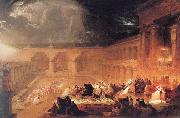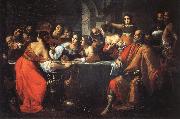Wholesale Oil Painting No Minimum |
|||||||||||
|
|
|||||||||||

|
|||||||||||
|
|
|
||||||||
|
|
||||||||
Belshazzar's Feast
Belshazzar's Feast Painting ID:: 3370 |
1630-35
National Gallery, London 1630-35 National Gallery, London |
|||||||
|
|
||||||||
John MartinBritish 1789-1854 John Martin Gallery His first exhibited subject picture, Sadak in Search of the Waters of Oblivion (now in the St. Louis Art Museum), was hung in the Ante-room of the Royal Academy in 1812, and sold for fifty guineas. It was followed by the Expulsion (1813), Paradise (1813), Clytie (1814), and Joshua Commanding the Sun to Stand Still upon Gibeon (1816). In 1821 appeared his Belshazzar's Feast, which excited much favorable and hostile comment, and was awarded a prize of £200 at the British Institution, where the Joshua had previously carried off a premium of £100. Then came the Destruction of Herculaneum (1822), the Creation (1824), the Eve of the Deluge (1841), and a series of other Biblical and imaginative subjects. The Plains of Heaven is thought to reflect his memories of the Allendale of his youth. Martin's large paintings were inspired by "contemporary dioramas or panoramas, popular entertainments in which large painted cloths were displayed, and animated by the skilful use of artificial light. Martin has often been claimed as a forerunner of the epic cinema, and there is no doubt that the pioneer director D. W. Griffith was aware of his work." In turn, the diorama makers borrowed Martin's work, to the point of plagiarism. A 2000-square-foot version of Belshazzar's Feast was mounted at a facility called the British Diorama in 1833; Martin tried, but failed, to shut down the display with a court order. Another diorama of the same picture was staged in New York City in 1835. These dioramas were tremendous successes with their audiences, but wounded Martin's reputation in the serious art world. |
||||||||
|
|
||||||||
|
|
Belshazzar's Feast
Belshazzar's Feast Painting ID:: 28220 |
1820
oil on canvas 95.3 x 120.6 cm
(37 1/2 x 47 1/2 in)
Yale Center for British Art Paul Mellon Collection New Haven CT.(mk63) 1820 oil on canvas 95.3 x 120.6 cm (37 1/2 x 47 1/2 in) Yale Center for British Art Paul Mellon Collection New Haven CT.(mk63) |
||||||
|
|
||||||||
Giovanni MartinelliItalian Baroque Era Painter, 1610-1659 |
||||||||
|
|
||||||||
|
|
Belshazzar's Feast
Belshazzar's Feast Painting ID:: 29963 |
mk67
Oil on canvas
89 3/4x134 1/4in
Uffizi,Gallery
mk67 Oil on canvas 89 3/4x134 1/4in Uffizi,Gallery |
||||||
|
|
||||||||
Miranda, Juan Carreno deSpanish, 1614-1685 was a Spanish painter of the Baroque period. Born in Avil's in Asturias, son of a painter with the same name, Juan Carreño de Miranda. His family moved to Madrid in 1623, and he trained in Madrid during the late 1620s as an apprentice to Pedro de Las Cuevas and Bartolom Roman. He came to the notice of Velezquez for his work in the cloister of Doña Maria de Aragen and in the church of El Rosario. In 1658 Carreño was hired as an assistant on a royal commission to paint frescoes in the Alcezar palace, now the Royal Palace of Madrid. In 1671, upon the death of Sebastian de Herrera, he was appointed court painter to the queen (pintor de cemara) and began to paint primarily portraits. He refused to be knighted in the order of Santiago, saying Painting needs no honors, it can give them to the whole world. He is mainly recalled as a painter of portraits. His main pupils were Mateo Cerezo, Cabezalero, Donoso, Ledesma y Sotomayor. He died in Madrid. Noble by descent, he had an understanding of the workings and psychology of the royal court as no painter before him making, his portraits of the Spanish royal family in an unprecedented documentary fashion |
||||||||
|
|
||||||||
|
|
Belshazzar's Feast
Belshazzar's Feast Painting ID:: 87378 |
17th century
Medium Oil on canvas
cyf 17th century Medium Oil on canvas cyf |
||||||
|
|
||||||||
|
Miranda, Juan Carreno de Spanish, 1614-1685 was a Spanish painter of the Baroque period. Born in Avil's in Asturias, son of a painter with the same name, Juan Carreño de Miranda. His family moved to Madrid in 1623, and he trained in Madrid during the late 1620s as an apprentice to Pedro de Las Cuevas and Bartolom Roman. He came to the notice of Velezquez for his work in the cloister of Doña Maria de Aragen and in the church of El Rosario. In 1658 Carreño was hired as an assistant on a royal commission to paint frescoes in the Alcezar palace, now the Royal Palace of Madrid. In 1671, upon the death of Sebastian de Herrera, he was appointed court painter to the queen (pintor de cemara) and began to paint primarily portraits. He refused to be knighted in the order of Santiago, saying Painting needs no honors, it can give them to the whole world. He is mainly recalled as a painter of portraits. His main pupils were Mateo Cerezo, Cabezalero, Donoso, Ledesma y Sotomayor. He died in Madrid. Noble by descent, he had an understanding of the workings and psychology of the royal court as no painter before him making, his portraits of the Spanish royal family in an unprecedented documentary fashion Belshazzar's Feast 17th century Medium Oil on canvas cyf |
||||||||
|
|
||||||||
|
Prev Next
|
||||||||
|
|
||||||||
|
Related Paintings to Miranda, Juan Carreno de :. |
||||||||
|
|
||||||||
|
CONTACT US |




